6 Property Management Trends for 2023
Property management industry trends often influence resident retention and acquisition. Here are the 6 latest trends that you need to know.
Our 2023 Resident Experience Management Report is hot off the press! If you want to know the newest and most interesting property management trends in 2023, this report is for you. And trust us, it’s full of insights to help companies thrive in the long run.
It’s a unique year to uncover the latest multifamily trends, especially as they relate to the resident experience. That’s because there have been so many unusual circumstances impacting the industry.
There’s been record levels of new apartment builds hitting the market. Rent growth is gradually dwindling. And property management companies are still struggling with high employee turnover.
All of these factors are impacting apartment communities. And it has an effect on resident experiences.
What trends in property management are influencing resident retention & acquisition?
Based on our research, there are 6 property management trends that are influencing resident retention & acquisition in 2023:
- Turnover costs remain close to $4,000 per resident
- Renter expectations have increased in the past year
- Companies believe resident retention will increase
- Tech-enabled experiences are the most important aspect of resident experience
- Staff turnover continues to fuel resident turnover
- Community appearance & maintenance are the biggest challenges in resident experience management
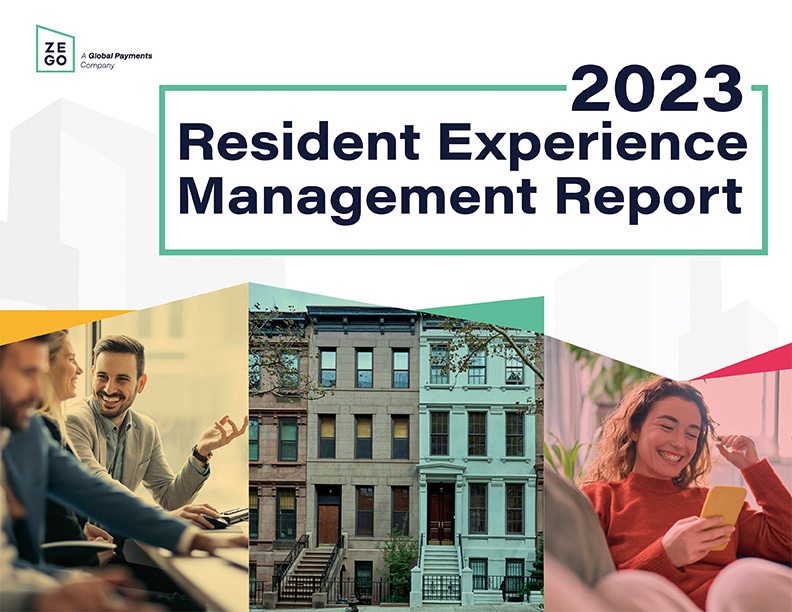
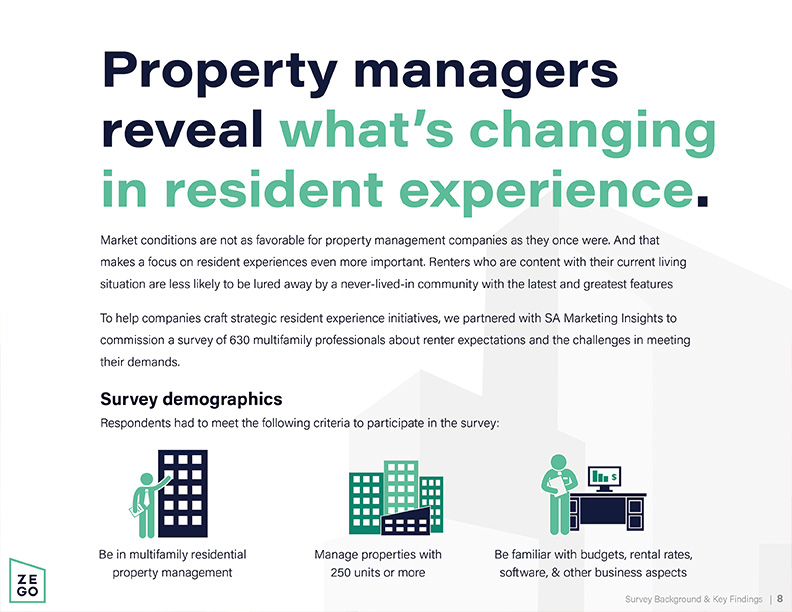
FREE DOWNLOAD
2023 Resident Experience Management Report
Learn the newest trends in resident experience and how companies are applying them to attract and retain more renters. Based on survey data from over 600 property management companies, this free report details what it takes to thrive in this new era.
The best way to understand how these dynamics are changing the resident experience is to hear first-hand from people in the industry. That’s why we commissioned a survey of over 600 multifamily professionals. Surveys were completed by those who manage a minimum of 250 multifamily units during March 2023.
#1: Turnover costs remain close to $4,000 per resident
Year after year, a top finding in our reports is how expensive it is to lose one resident. Turnover costs were (and still are) the top reason to focus on resident retention for multifamily communities.
And with the economy becoming so unpredictable, we wanted to see how turnover costs are being impacted. Interestingly enough, turnover costs have held steady since 2021.
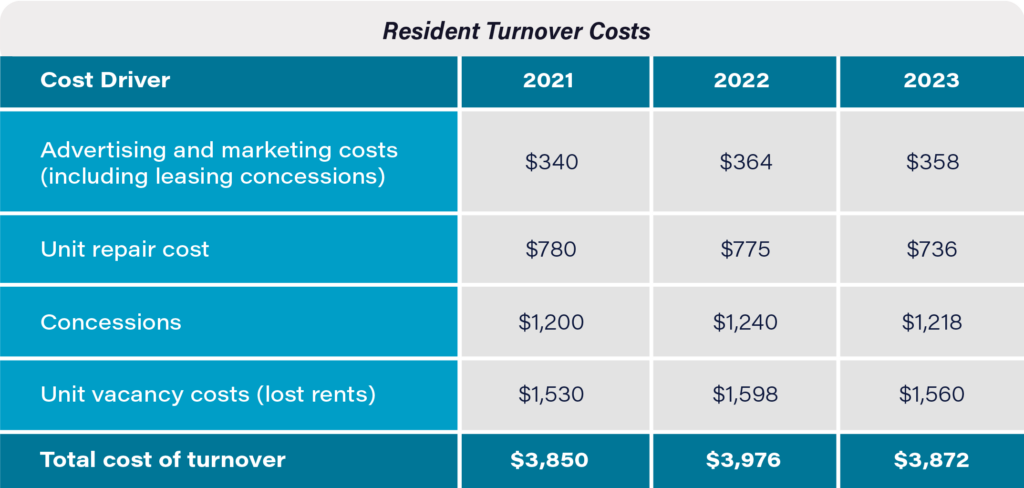
Each time you lose a resident, the costs of turning their unit are about $4,000! That really adds up if your communities don’t have great retention rates.
And, the financial impact lingers well beyond the point your resident leaves. Depending on how long your lease terms are and how long the next occupants of that unit stay, you may cycle through two or three more renters before your original turnover costs are recovered! This snowball effect alone is why companies minimize turnover as much as possible.
#2: Renter expectations have increased in the past year
When you’re faced with a price increase, you may expect more in return. After major rent increases across the nation, we wondered if apartment operators were seeing higher expectations from their renters. They have. 75% of apartment operators say renter expectations have risen in the past year.
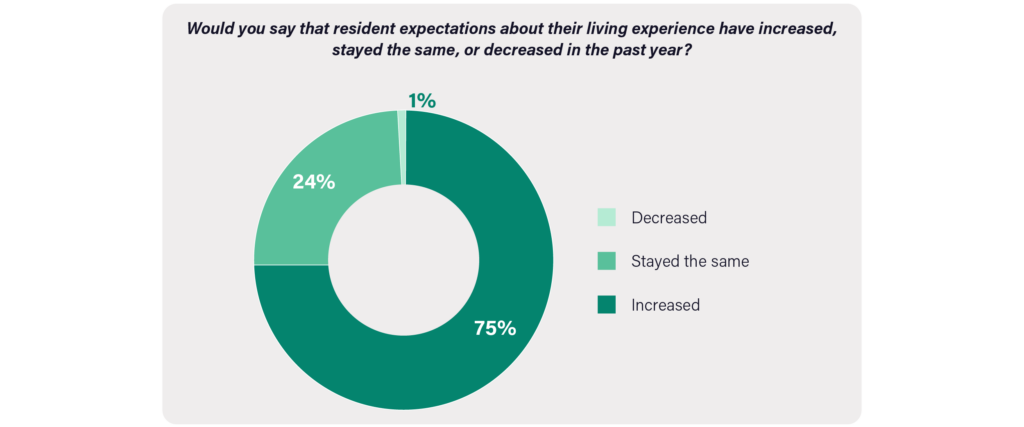
Amenities, community technology come with the highest expectations
Most apartment operators think resident expectations have increased in the past year. Of those respondents, we asked them to identify the specific areas where residents have increased their expectations.
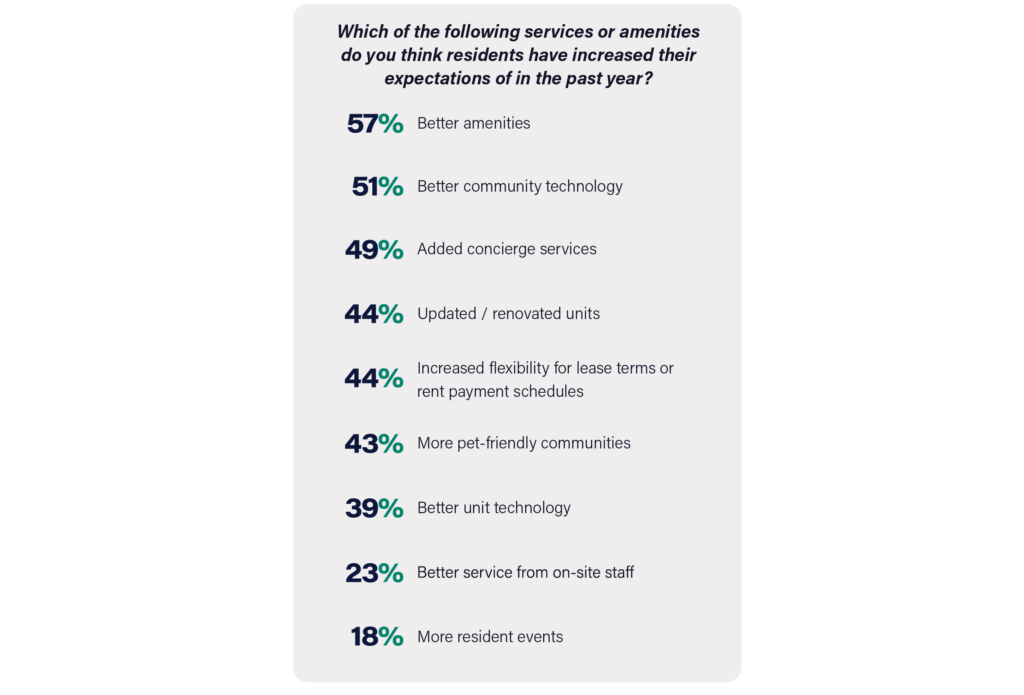
“Better amenities” is the most commonly-noted area of higher expectations. Closely following it is “better community technology.” The better the amenities, the more value residents derive from the community. Amenities that enhance day-to-day life or deliver convenience may justify increasing rental rates for some residents.
Community technology is also equally scrutinized by renters, especially by younger demographics like Gen Z and Millennials. Defined to survey respondents as things like property-wide high-speed WiFi, EV charging stations, or mobile community apps, these amenities are essential for renters. In fact, respondents in NMHC’s Renter Preferences Report named reliable cell phone service as the #1 must-have community amenity.
That’s because the lifestyle of today’s renter revolves around technology. As more people work from home and also rely on the internet for things like streaming, virtual assistants, or in-home smart technology, WiFi has become a major part of the apartment living experience. If renters struggle with connectivity, they’re probably going to look elsewhere to find a better experience and somewhere that better supports their lifestyle.
#3: Companies believe resident retention will increase
There’s a lot of debate about how the economy and the multifamily industry will perform in the future. With many not-so-optimistic predictions floating around, not to mention an influx of new builds coming on the market, we wondered how companies thought resident retention would fare.
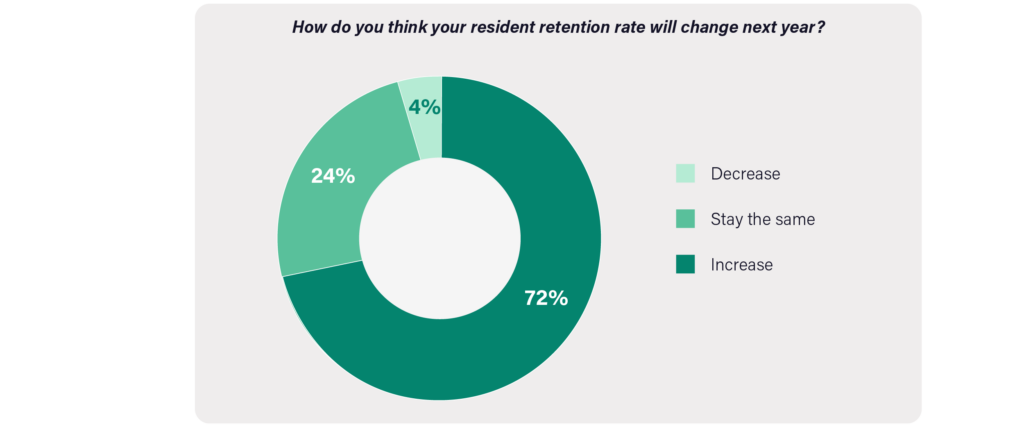
7 in 10 respondents think their resident retention rate is going to increase. This is surprisingly optimistic given the increase in both new inventory and renter expectations. Furthermore, the average renter retention rate has roughly stayed the same over the past three years even throughout times of record performance.
In 2023, the average resident retention rate for multifamily companies is 56% – that’s down a percentage point from last year. Raising retention rates may prove more difficult than anticipated if the right strategies are not used. If companies are truly dedicated to raising their retention rate in the next year, a focus on customer service and differentiated living experiences will be key.
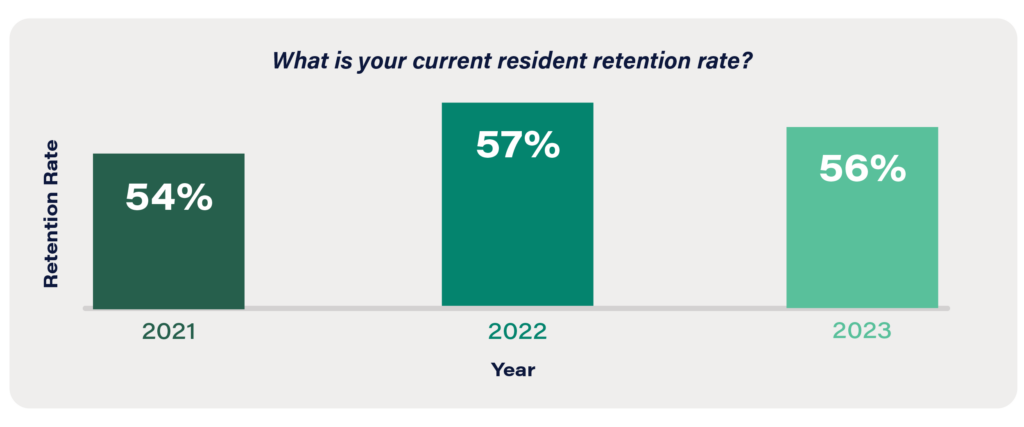
#4: A tech-enabled lifestyle is the most important aspect of the resident experience
Offering a well-rounded living experience is critical for resident retention and acquisition. But some factors bear more weight than others. Survey respondents were asked to identify the most important aspect of the community living experience in the eyes of their renters. At the top of the list is a tech-enabled lifestyle.
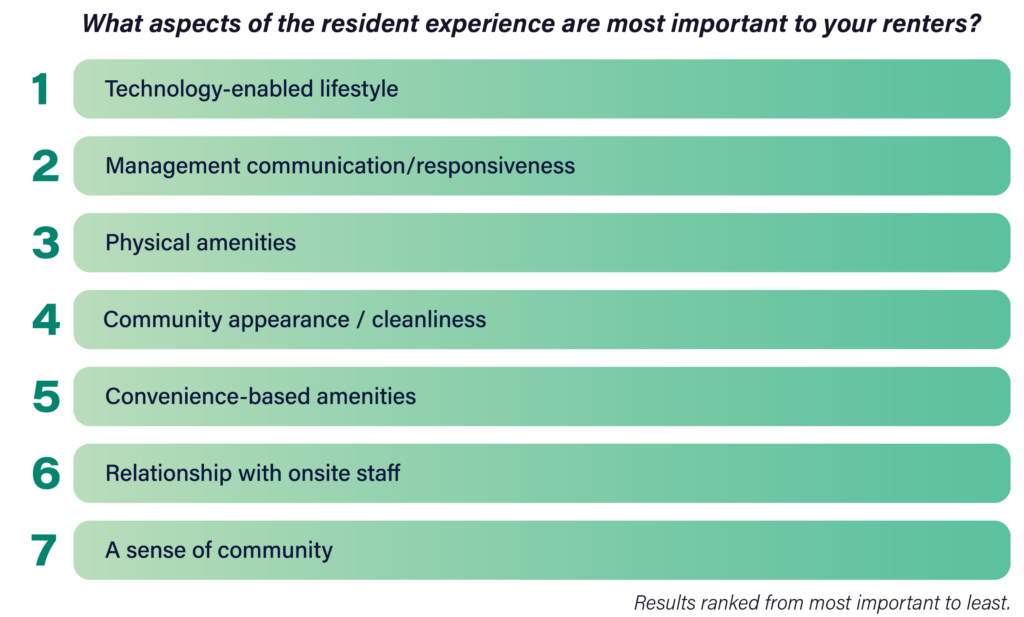
There’s no question that technology helps deliver a higher caliber resident experience. So it’s not surprising that more and more residents are making leasing and renewal decisions based on the tech-centric features in a community.
The right technology eliminates friction points of apartment living (access control, paying rent, package acceptance, etc.), adds value to the community, and facilitates seamless living experiences. And with the shift to remote work, reliable connectivity is a must for renters. Communities that lack consistent and fast connectivity won’t be able to retain renters for the long term.
Action Items
#5: Staff turnover continues to fuel resident turnover
Last year’s Resident Experience Management Report found a correlation between staff turnover and resident turnover. Companies with higher levels of staff turnover also experienced above average renter turnover. We revisited this correlation to see if the impact of staff turnover is still hurting resident retention rates. Unfortunately, they are.

For two years running, higher staff turnover continues to propel higher resident turnover. Companies with low staff turnover have higher resident retention rates, with 1 in 4 retaining over 70% of their residents. In 2023, companies with staff turnover lower than 20% see an average resident retention rate of 60%. Compare that to a 54% resident retention rate for companies who have staff turnover more than 20%.
Interactions between on-site teams and residents not only influence resident retention, they also influence your online reputation. Reputation’s 2022 Property Management Report finds that the #1 driver of negative reviews about a property is the service given in the rental office. When your on-site teams are overworked or unhappy in their job, that energy often carries over to the service they provide residents. This is important, because 56% of renters said the professionalism of the rental office was the biggest driver for them leaving a review.
#6: Community appearance and maintenance are the top challenges for resident experience
Renter satisfaction depends upon several factors. From move-in to ongoing customer service, multifamily operators have several opportunities to make or break the resident experience. We wanted to know what apartment operators consider the most challenging part of delivering a good resident experience. The top two responses center around property upkeep. “Keeping physical property visually appealing and modernized” and “Managing repairs and maintenance” are the #1 and #2 responses.
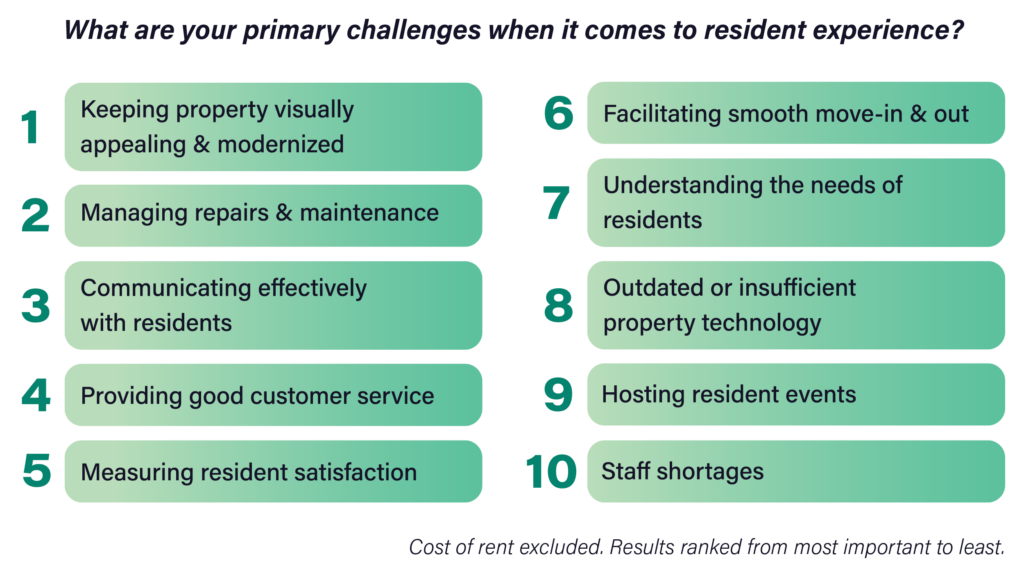
A pleasant community experience is essential to 35% of renters
According to NMHC’s Renter Preferences Report, the overall condition of a community is one of the most important factors that renters consider when making lease decisions.51% of renters say it is “very important” in their decision to sign a lease, while 35% say it is “absolutely essential.” In fact, aside from the rental rate, no other leasing factor bears as much importance as the property appearance.
Given these responses from renters, it’s disconcerting that maintenance and keeping the property attractive is the top struggle. Renters clearly have high standards about property appearance. If companies cannot satisfy these expectations, they face losing potential renters.
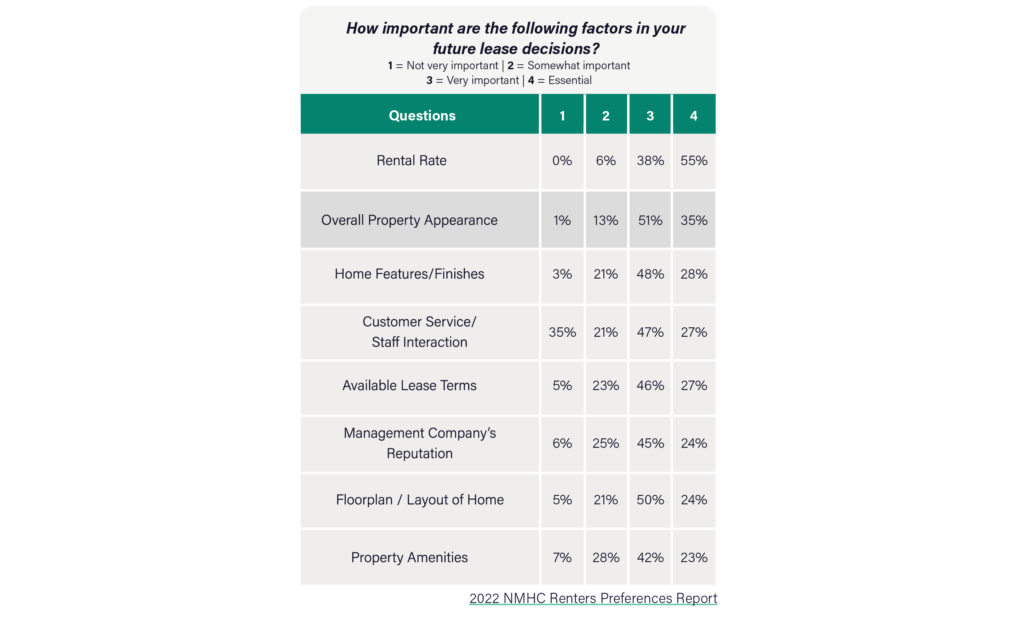
More insights & best practices from our Resident Experience Report
If you think any of these property management industry trends are interesting, you’ll definitely want to give the full report a read. We not only elaborate further on these trends, but we also offer recommendations to help to thrive in this market. Read the 2023 Resident Experience Management Report now!
Want to improve your resident experience program?
Get a custom demo to see how our all-in-one community app can help on-site teams go above and beyond for your residents.